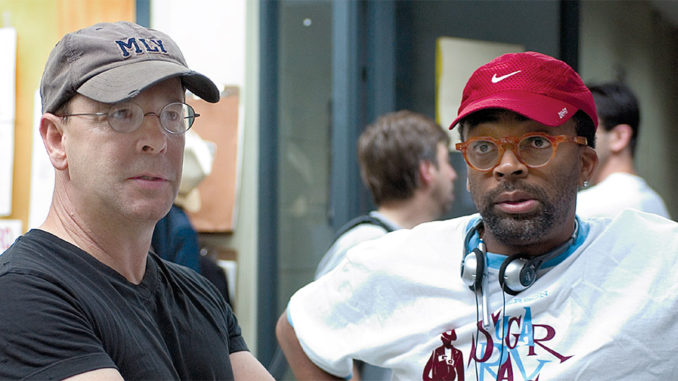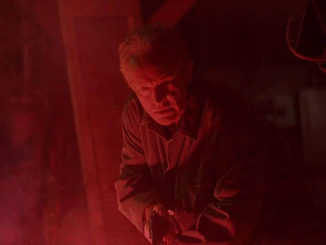
by Kevin Lewis
Although he was only in his 20s, Barry Alexander Brown edited the early films of Spike Lee and Mira Nair, two of the small circle of independent filmmakers who were courted and signed by the mainstream studios in the mid-1980s. The editor was invaluable to them because he thought like a filmmaker and anticipated their decisions.
He has gone on to work with both directors throughout his career, especially Lee, for whom he has edited most of the feature films, television films, MTV videos and commercials from the director’s own production studio, 40 Acres and a Mule, located in Fort Greene, Brooklyn. Currently, Brown is editing Lee’s Inside Man, a police drama starring Denzel Washington, Clive Owen and Jodie Foster, which is due for release next year.
Brown has been a great friend to Lee ever since they met in the summer of 1981 in Altanta, where Lee’s alma mater Morehouse College is located. Later, Lee, a native Brooklynite, was enrolled in the graduate filmmaking program at New York University, where he made his thesis film Joe’s Bed-Stuy Barbershop/We Cut Heads. Brown was then a co-founder of First Run Features and gave Lee a job handling film at the company, which distributed independent films. He subsequently became an additional editor on Lee’s films with the director’s professional debut, She’s Gotta Have It (1986), cutting the memorable feather boa sex scene between Nola and Greer.
But Brown’s first brush with filmmaking came much earlier than that. He was born in 1960 in England where his father was stationed in the Air Force, and moved to the United States when he was just over a year old. When his family was living in Madison, Wisconsin in the mid-1970s, he met Glenn Silber and the two co-directed a documentary on an anti-Vietnam student demonstration in Madison called The War at Home (1979). Brown literally learned editing on-the-job while he was researching stills and film footage for the project, and credits this experience as a seminal moment in his editorial career.
Barry Alexander Brown and Spike Lee are so emotionally and artistically in sync that it sometimes frustrates other members of the 40 Acres and a Mule team.
At the age of 19, he was nominated for an Academy Award for Best Feature Documentary for The War at Home, which he admits was such a heady experience that he “emotionally crashed.” He edited films during the early 1980s, with aspirations of making his own films again. Brown’s editing of the documentary High Wire (1984) was admired––particularly by a friend of director Nair. This led to Nair asking him to cut India Cabaret (1986), the documentary she made in India, and subsequently her breakthrough feature Salaam, Bombay! (1988).
“On some level, I am more of a natural editor than a director,” Brown claims, citing his penchant for losing himself in the editing process and becoming mesmerized when a scene develops through editing. For that reason, he prefers to work uninterrupted without outside distractions: “Me and the material, and that’s it.”
Because of the success of She’s Gotta Have It, Lee received studio backing for School Daze (1988) and hired Brown to edit it. “I had never cut 35 before and I had never even been in a 35mm editing room,” Brown confesses. “I basically had to teach myself how to do stuff, and even how a 35mm room should be organized, so I had my own way of doing it. But I also discovered that I could cut very, very fast as long as nobody talked to me all day.”
Lee’s next film, Do the Right Thing (1989), was controversial, revolutionary and innovative. It made Lee a household name, and Brown an editor in demand. After its success, pop star Madonna hired Brown to edit Alek Keshishian’s documentary of her tour, Madonna: Truth or Dare (1991), for which he was nominated by the American Cinema Editors (ACE) for Best Edited Documentary.
After that, Brown wanted to get back into making his own movies, and during this period directed Lonely in America. Meanwhile, Lee hired Sam Pollard to edit his next two films, Mo’ Better Blues (1990) and Jungle Fever (1991). Regarding his editing colleague Pollard, Brown says, “Sam Pollard came up through the ranks of editing and his approach is very different, much more thoughtful than mine, more intellectual.” (Pollard is currently doing additional editing on Lee’s Inside Man.)
Because Spike Lee uses multiple cameras, each capturing a different angle in a scene, there was a myriad of editorial choices.
“I had come back to New York, really thinking I wasn’t going to do any more editing,” Brown recalls. “And then Spike did Malcolm X [1992]––and I couldn’t say no to Malcolm X. He was back with Lee, and the collaboration continues to this day due to their special working relationship.
“Spike and I grew up in film together,” explains Brown. “We can finish each other’s thoughts.” Longtime Lee assistant editor Leander Sales (see accompanying story) realized early on that Brown and Lee communicate in verbal shorthand, which Brown readily acknowledges. He and Lee are so emotionally and artistically in sync that it sometimes frustrates other members of the 40 Acres and a Mule team. So linked are they that Brown can anticipate Lee’s editorial choices.
“I remember the time when Spike left me in charge of a sound mix for a picture. I got to a point and said, ‘No, no––we’ve got to do it this way.’ It was a big enough change, and everybody looked at me and said, ‘No, come on––you’re the editor; a big change like that comes from the director,’ and I said, ‘Let’s just do it. Spike doesn’t have to be here; do it.’ Everybody was grumbling and didn’t want to do it, but finally they did it. I remember I was pissed off that they wouldn’t respect my authority. Spike came in the next day and he looked at the piece and made the same change––and they were all dumbfounded, like Spike and I had already talked about it. But we were just on the same wavelength. We had done so many things together, early on, that we learned a lot, and we were learning together.”
Though Brown edits on his Avid using Film Composer, he has a lasting affection for his Steenbeck, which has a place of honor at 40 Acres and a Mule. Summer of Sam (1999) was the last Lee film to use the venerable film editing machine. “Spike and I held onto it as long as we could,” says Brown. However, the fantasy sequence in The 25th Hour (2002) was edited on a Steenbeck because Brown felt more comfortable cutting that complex sequence on film rather than digitally.
Do the Right Thing (1989), was controversial, revolutionary and innovative. It made Spike Lee a household name, and Barry Alexander Brown an editor in demand.
Brown regards the documentary he edited for Lee, The Original Kings of Comedy (2000), as more of a concert film than a documentary, and says he edited from a theatrical rather than a documentary approach. Referencing a comment by his friend, documentary filmmaker Emile de Antonio, about there being little difference between editing fictional and documentary material, he says, “You create characters, you create drama, you create story [in both].”
Brown believes that most films are motivated by performance rather than just plain action. “Sometimes, what you might call action is really inaction…..Like in Do the Right Thing,” he says. “There was a point in the film where after Sal had beat up the boom box, I thought, ‘You know what we need? We need everything to be suspended here for a moment,’ and Spike said, ‘Sure, suspend it.’ But what he had done is that before each take––before all the characters jumped in and started fighting––he had the camera on them.”
The audience saw the suppressed tension of the people, and Brown cut around the room, showing everyone looking at the boom box, waiting to jump forward. Because Lee uses multiple cameras, each capturing a different angle in a scene, there was a myriad of editorial choices. The advantage of Avid is that Brown can tie up to eight camera angles together from a single take, and compare the camera angles side-by-side to choose the one which best expresses the scene.
“On some level, I am more of a natural editor than a director… Me and the material, and that’s it.” – Barry Alexander Brown
Discussing his friend and collaborator, Brown says, “There’s always been an independent spirit about Spike, though many of his pictures are studio pictures. In general, the studios treat him a little bit differently because he is who he is. Maybe because he’s a New York filmmaker, and also because of his background. He is also a consummate professional––meaning that he makes pictures that are on time and on budget. And his vision is so personal.”
Concurrent with his editing of Inside Man, Brown is shooting a documentary called Sidewalk, about street sellers of books in Greenwich Village. Ironically, he doesn’t edit the films he directs. “No, most of the time I don’t edit,” he says, claiming that he cannot “think very freshly” about the editing process when he’s also directing. So whom does the editor select to edit his films? “Usually somebody I’ve known for a long time,” he responds, “like K. A. Chisholm [The Original Kings of Comedy, Winning Girls], who has been my assistant on several films, or Allyson C. Johnson [The Who’s Tommy: The Amazing Journey, Straight No Chaser].
“When I’m editing, I’ve just got to let myself go, because I’m a very instinctual editor,” he concludes. “I don’t think a lot about it; I can feel it.”





